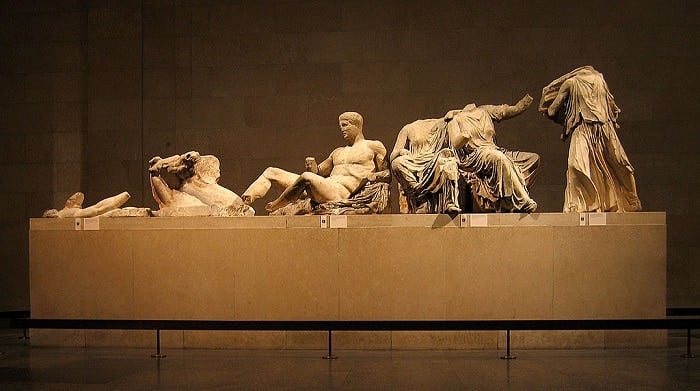
The Year 2016 marked 200 years since Greece was robbed of its famous Parthenon Marbles, known around the world as the so-called “Elgin Marbles;” the culture crime was committed by Thomas Bruce, the Seventh Earl of Elgin and a Scottish nobleman.
Over the decades, there have been countless petitions by citizens, politicians, and celebrities from around the world to return the marble sculptures to their rightful home, atop the Acropolis in Athens, Greece.
There have even been offers to trade antiquities from Greece to the UK in hopes that the British Museum might consider “loaning” them back to Greece. However, the British Museum has declined all options and offers.
The director of the Museum, Hartwig Fischer, said in an interview published by Greece’s Ta Nea newspaper, that the marbles belong to the British Museum and that Greece has no legal claim to them.
The real history behind the Parthenon Marbles
What’s the real story behind how these priceless ancient Greek antiquities, which have a home waiting for them in the Acropolis Museum next to the Parthenon in Athens, ended up on display in a museum in the UK? How is it that antiquities that were chipped off a building, and which are part of a country’s culture and identity, can belong to another country that has nothing to do with them at all?
It all happened sometime between 1801 and 1805. These are the years that Lord Elgin was in Athens as a diplomat. The story goes that he was such an admirer of Ancient Greece and the artifacts that he decided to “take” some back to England when he returned.
The British Museum claims that Lord Elgin didn’t “steal” the artifacts. Instead, the museum insists that Elgin took them with the complete knowledge and permission of the Ottoman authorities. During the time when Lord Elgin was ambassador to the Ottoman Empire, Athens was under its rule.
Of the items that Lord Elgin, took from atop the Acropolis, it is estimated that he looted some 247 feet of frieze from the Parthenon, what is commonly referred to today as the so-called “Elgin Marbles”. Furthermore, it is believed that Elgin took around half of what was still standing of the Parthenon at that time.
Elgin shipped his loot to England and in 1816 he sold the marble statues for £35,000 — nowhere near its estimated market value; while to Greece, they are a priceless piece of the country’s culture.
Eventually, they were acquired by the British Museum in London. However, even back in the early 1800s, the legitimacy over “ownership” of the marbles was controversial. Only after a Parliamentary Select Committee debated the legality of Elgin’s ownership, where Elgin argued that the sculptures would be better cared for in Britain than in Greece, did the museum finally take possession of the Parthenon antiquities.
The marble sculptures date back over 2,500 years and were first constructed in honor of the Greek goddess, Athena. The Parthenon, which has also served as a Christian church and a Muslim mosque, was ruined in 1687 following Ottoman attacks on the structure, which, at the time, housed gunpowder, and caused a massive explosion.
The Parthenon has fragments of its remains scattered throughout museums in eight different nations since 2009. These include The British Museum, the Louvre, the Vatican collection, and the new Acropolis Museum in Athens. As for the Parthenon Sculptures, however, they are split evenly between London and Athens.
During the 1980s the Greek Government officially asked the British Museum to permanently repatriate the marbles, citing that they are a crucial part of Greek culture and heritage and that they were, in effect, taken with the permission of a foreign-ruling government, a few years before Greece regained its independence.
The museum has continually refused to return the marbles to Greece.
Not only does the museum claim to have “rescued” the marbles from further damage by keeping them in the UK, it also says that Greece has no legal rights to the antiquity.
Nowadays, items Lord Elgin looted from the Parthenon are increasingly finding their way to being called their rightful name, the “Parthenon Sculptures” instead of the “Elgin Marbles”. So, why aren’t they being returned to their rightful home?
Even British politicians have tried to pass bills demanding that the Parthenon Sculptures be returned to Greece. As recently as 2016, A new UK bill, “The Parthenon Sculptures (Return to Greece),” was presented by a joint panel composed of Liberal Democrat MP Mark Williams, supported by Conservative Jeremy Lefroy and 10 other MPs from Labor, the SNP and Plaid Cymru.
“This Bill proposes that the Parliament should annul what it did 200 years ago. In 1816 Parliament effectively state-sanctioned the improper acquisition of these impressive and important sculptures from Greece,” Williams said according to the independent.co.uk.
“It’s time we engaged in a gracious act. To put right a 200-year wrong,” he said, concluding with sentiments felt by so many people around the world, “These magnificent artifacts were improperly dragged and sawn off the remains of the Parthenon.”
See all the latest news from Greece and the world at Greekreporter.com. Contact our newsroom to report an update or send your story, photos and videos. Follow GR on Google News and subscribe here to our daily email!



